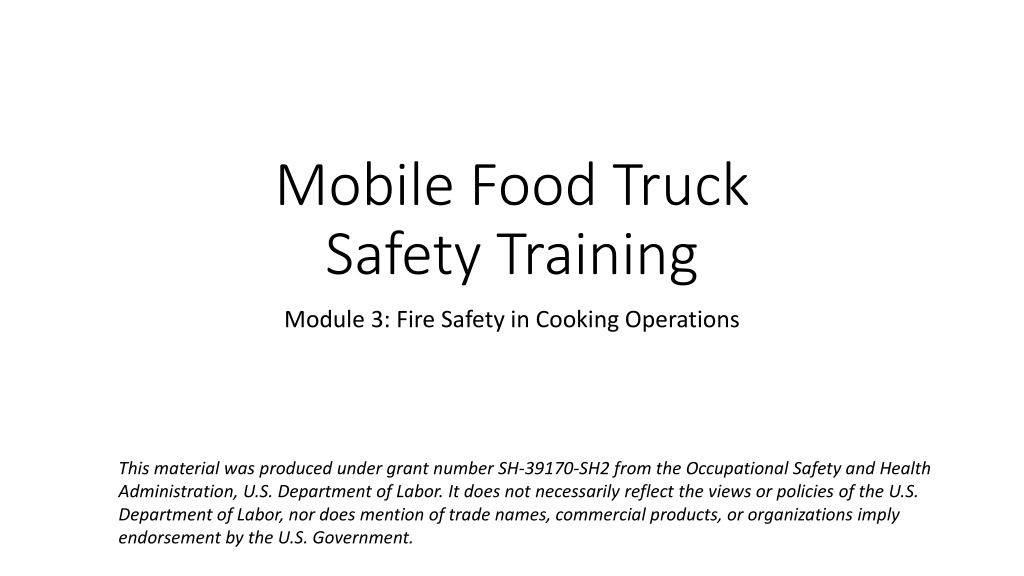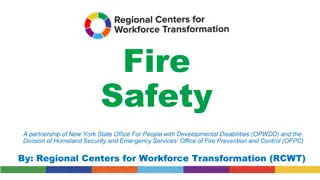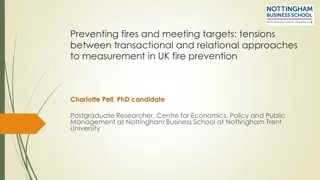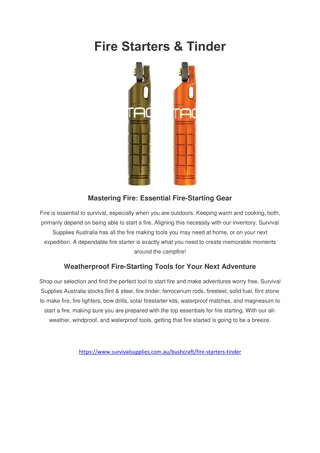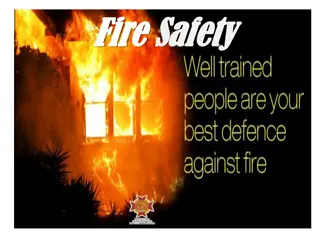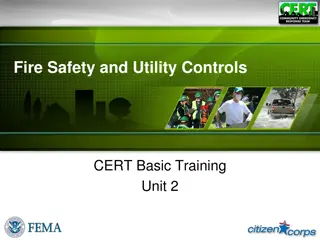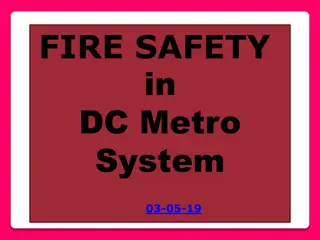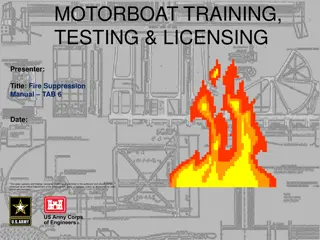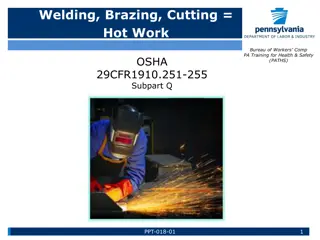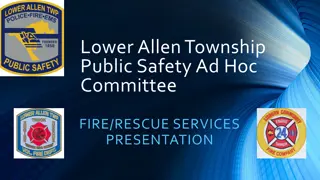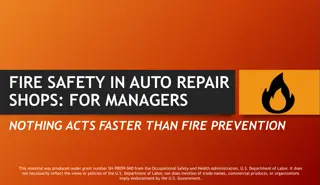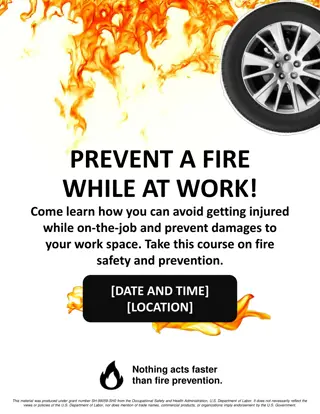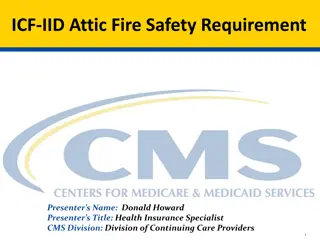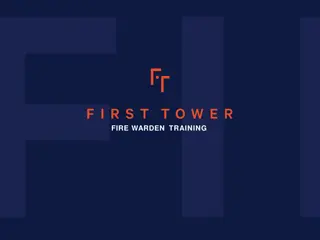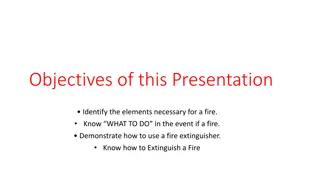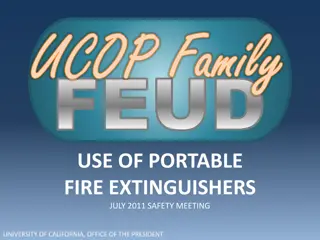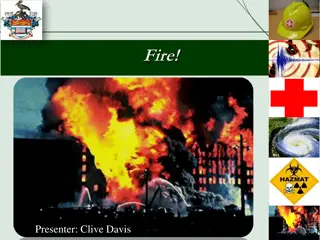Food Truck Fire Safety and Prevention Guidelines
This training module focuses on fire safety in mobile food truck operations, covering hazards, controls, and prevention measures related to propane, generators, cooking appliances, and fire prevention plans. It emphasizes the importance of fire prevention plans, proper handling of hazardous materials, and general fire safety guidelines for food trucks to ensure a safe working environment.
Download Presentation

Please find below an Image/Link to download the presentation.
The content on the website is provided AS IS for your information and personal use only. It may not be sold, licensed, or shared on other websites without obtaining consent from the author.If you encounter any issues during the download, it is possible that the publisher has removed the file from their server.
You are allowed to download the files provided on this website for personal or commercial use, subject to the condition that they are used lawfully. All files are the property of their respective owners.
The content on the website is provided AS IS for your information and personal use only. It may not be sold, licensed, or shared on other websites without obtaining consent from the author.
E N D
Presentation Transcript
Mobile Food Truck Safety Training Module 3: Fire Safety in Cooking Operations This material was produced under grant number SH-39170-SH2 from the Occupational Safety and Health Administration, U.S. Department of Labor. It does not necessarily reflect the views or policies of the U.S. Department of Labor, nor does mention of trade names, commercial products, or organizations imply endorsement by the U.S. Government.
Objectives After this module, the trainee will be able to: Recognize the 3 hazards identified as most serious for food trucks Recognize that the hazard controls needed will depend on the types of heating and energy sources present Identify ways to control general fire safety hazards Identify ways to control hazards associated with generator use Identify ways to control hazards with solid fuel use
What energy/heat sources do you have? Type of Vendor Food Truck Food Trailer Cart or Tent Heating and Energy Sources Propane Solid fuel (wood, charcoal, etc) Electricity (Generator)
Focus Areas in Food Truck Safety Propane: NFPA statistics indicate that ~60% of Mobile Food Vehicle fires are related to propane, and most injuries/deaths have involved propane explosions Generators: Two issues are present: electrical hazards and carbon monoxide, both of which can be deadly when not prevented. Cooking Appliances/Hood Suppression Systems: Multiple kinds of cooking appliances may be present and methods of extinguishing fires for each must be present as well. All of these items may need consideration in a Workplace Fire Prevention Plan
Fire Prevention Plans Purpose: To prevent a fire from occurring in a workplace. A Fire Prevention Plan must be in writing, be kept in the workplace, and made available for employees to review. Requirements: A list of all major fire hazards, proper handling/storage of hazardous materials, potential ignition sources and controls, and the type of fire protection equipment needed for each hazard. Procedures to control accumulations of flammable/combustible waste materials. Procedures for regular maintenance of safeguards on equipment. The name of employees responsible for maintaining equipment to prevent fires and for controlling fuel source hazards. https://www.osha.gov/etools/evacuation-plans-procedures/emergency-standards/fire-prevention
General Fire Safety Guidelines Obtain license or permits from local authorities Ensure clearance of at least 10 feet from buildings, structures, vehicles, and any combustible materials Verify fire department vehicle access is provided for fire lanes and access roads Ensure access to fire hydrants Ensure that power sources are separated from the public by barriers, physical guards, fencing.
General Fire Safety Guidelines (continued) Check that appliances using combustible media are protected by an approved fire extinguishing system. Verify that portable fire extinguishers have been selected and installed in cooking areas. Note: Propane Safety will be covered separately in Module 4
Solid Fuel Safety Checklist (Wood, Charcoal) Do not store fuel above any heat-producing appliance or vent. Do not store fuel closer than 3 ft to any cooking appliance. Do not store fuel near any flammable liquids, ignition sources, chemicals, and food supplies or packaged goods. Do not store fuel in the path of the ash removal or near removed ashes. Remove ash, cinders, and other fire debris from the firebox at regular intervals and at least once a day. Remove ashes, cinders, and other fire debris, place in a closed, metal container.
Generators and Electrical Safety Wilson, NC A 57-year-old worker was electrocuted in a food trailer, apparently by an extension cord. Passerby who found him felt a shock when she turned him over. NC Medical Examiner s Office listed electrocution as cause of death. OSHA fined the food truck company for 8 violations Food truck was cluttered with supplies and appliances Water was on the floor of the truck Multiple extension cords were used to run electricity from building to inside of truck Both end of the extension cords appeared to have been replaced Previously, an electrical issue with a generator caused a fire that burned the inside of the truck in Aug 2020, and the truck was now pulling the trailer that was involved. https://restorationnewsmedia.com/articles/local-news/business-cited- fined-after-workers-electrocution/?pub=wilsontimes Sept 17, 2021
Generator Safety Portable electric generators power many food trucks but they need to be installed and operated correctly Contact a licensed electrician to install your generator and to make sure it meets local codes Make sure the generator is properly grounded and that an appropriate transfer switch is used to connect the generator to the mobile kitchen Do not overload the generator Ensure that it is shut down and cool to the touch before refueling from a portable container Use Ground Fault Circuit Interrupters (GFCI) to prevent electrocutions and shock injuries
Generator Safety- continued Additional Guidelines Generators should be at least 12 ft from openings and air intakes into trailers/trucks (and any means of egress) Do not operate the generator in enclosed or partially enclosed spaces carbon monoxide Directed away from all buildings and other cooking vehicles and operations Use carbon monoxide detectors in nearby enclosed spaces to monitor levels
Gas Detectors inside the Truck/Trailer Gases can gather inside enclosed areas like food trucks and trailers Carbon monoxide (CO) An invisible, odorless gas that can cause carbon monoxide poisoning, death Can be produced from generators or other engines Propane, other flammable gases Can result in explosions Can come from leaks in piping between tanks, burners Gas detectors can save lives! Note: May not be applicable to open air carts/tents.
Cooking Surfaces In brick-and-mortar operations, cooking fires represent a major source of loss Several food truck fires have occurred after burners were left on unattended Checklist: Do not leave cooking equipment unattended while it is still hot Operate cooking equipment only when all windows and ventilation sources are fully opened Close gas supply valves when equipment is not in use. Keep cooking equipment, including the ventilation system clean by regularly removing grease.
Fire Suppression Systems and Hoods Fire Extinguishing/Suppression Systems are commonly used to protect cooking areas where fires may start and quickly spread Goal: Quickly extinguish a developing fire and alert occupants before extensive damage occurs Guidance: Hire a professional service to install- the best system for your workplace may depend on multiple factors that the installer will review The system should be inspected annually and operated/maintained in a working condition. Notify employees how the system works. If the system potentially exposes a worker to chemicals, hazard communication about the chemical s hazards is needed.
In Summary Multiple hazards exist for food operations, including food trucks/trailers A fire prevention plan should be in place to list the fire safety hazards and ways to control them. Generators pose both electrical and carbon monoxide hazards- use electrical safety controls and gas detectors inside enclosed spaces to notify of the presence of dangerous gases Fire Suppression Systems are required in most jurisdictions to quickly extinguish kitchen fires but inspections and maintenance are required.
